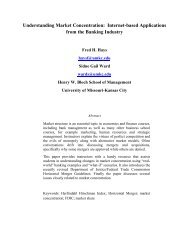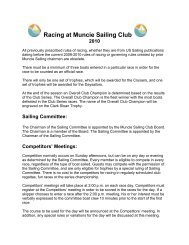The Balanced Scorecard with Time-Driven Activity Based-Costing ...
The Balanced Scorecard with Time-Driven Activity Based-Costing ...
The Balanced Scorecard with Time-Driven Activity Based-Costing ...
You also want an ePaper? Increase the reach of your titles
YUMPU automatically turns print PDFs into web optimized ePapers that Google loves.
<strong>The</strong> <strong>Balanced</strong> <strong>Scorecard</strong> <strong>with</strong> <strong>Time</strong>-<strong>Driven</strong> <strong>Activity</strong> <strong>Based</strong>-<strong>Costing</strong>:<br />
An Incremental Approach Model to Health Care Cost Management<br />
Charles J. Pineno<br />
Shenandoah University<br />
cpineno@su.edu<br />
ABSTRACT<br />
<strong>The</strong> balanced scorecard represents a technique used in strategic management to translate<br />
an organization’s mission and strategy into a comprehensive set of performance measures that<br />
provide the framework for implementation of strategic management. This article develops an<br />
incremental approach for decision-making by formulating a specific balanced scorecard model<br />
utilizing time-driven activity-based costing <strong>with</strong> an index of non-financial as well as financial<br />
measures. <strong>The</strong> incremental approach to costs, including profit contribution analysis and<br />
probabilities, allows decision-makers to assess, for example, how their desire to meet different<br />
health care needs will cause changes in service design. This incremental approach to the<br />
balanced scorecard may prove to be useful in evaluating the existence of causality relationships<br />
between different objective and subjective measures to be included <strong>with</strong>in the balanced<br />
scorecard.<br />
INTRODUCTION<br />
<strong>The</strong> balanced scorecard represents the technique used in strategic management. It is a rather<br />
comprehensive set of measures that is used to communicate and evaluate achievement of the<br />
mission and strategy of the organization. <strong>The</strong> balanced scorecard traditionally includes both<br />
objective and subjective measures divided into four major areas: (1) financial perspective –<br />
profitability measures, (2) customer perspective – articulate the customer and market, (3) internal<br />
business process – operation and innovation cycles, and (4) learning process and growth<br />
perspective – employee related measures and organizational procedures [13]. <strong>Activity</strong> basedcosting<br />
enables indirect and support expenses to be driven, first to activities and processes, and<br />
then to products and services. <strong>The</strong> incremental approach is based on the introduction of small<br />
changes in one or more parameters to estimate the effect on the profit of the organization.<br />
Generally, the focal point of cost-volume-profit analysis is to determine the break-even<br />
sales amount and the total sales required for a target profit. In today’s competitive global market,<br />
this focal point must go beyond break-even analysis to an incremental approach to costs because<br />
different patients’ needs require changes in product or service design. Different patients expect<br />
different product or service mixes. <strong>The</strong>ir needs differ and they need different levels of health<br />
care [2]. Since there are different types of demand for certain products or services, management<br />
is anxious to know the incremental effect on the bottom line.<br />
BACKGROUND<br />
Throughout the history of performance measurement and performance pay, there has been a<br />
persistent problem when monitoring and paying on one dimension of a job. <strong>The</strong> result is often a<br />
decline in one or more additional dimensions. For example, pay based on patients handled may
cause quality to suffer. G.H. Felix and J.L. Riggs introduced the performance matrix in 1986 as a<br />
possible solution to such a problem. <strong>The</strong> matrix was composed of a group of performance<br />
measures that are priority weighted. <strong>The</strong> sum of the weighted measures is computed to reflect a<br />
balanced “performance index” or “success indicator”. Pay based on the index, rather than the<br />
individual performances, ensures that employees attend to all the key performances associated<br />
<strong>with</strong> their jobs. Robert Kaplan and David Norton expanded the concept of balanced performance<br />
in 1992 to include performances that affect future organizational outcomes, learning, and growth.<br />
<strong>The</strong> basic concept came to be called the balanced scorecard [1].<br />
<strong>The</strong> balanced scorecard is a customer-based planning and process improvement system<br />
aimed at focusing and driving the change process. It does this by translating strategy into an<br />
integrated set of financial and non-financial measures that communicates the organizational<br />
strategy to the employees and provides them <strong>with</strong> actionable feedback and attainment of<br />
objectives.<br />
According to Fielden [9], corporations across the world have begun leveraging the power of<br />
balanced scorecards for converting vision and strategy into measurable targets. Introduced in<br />
1991 by Robert S. Kaplan and David P. Norton as a management tool, balanced scorecards<br />
provide executives <strong>with</strong> the ability to develop measures that could accurately forecast the health<br />
and wealth of an organization. By providing the ability to translate strategy into action rapidly,<br />
measurably, and knowledgeably, a balanced scorecard aligns that strategy <strong>with</strong>in an<br />
organizational structure to tap into hidden assets and knowledge. Moreover, by connecting both<br />
internal and external people <strong>with</strong> these strategies, continual learning and growth can be achieved.<br />
According to Bailey, Chow, and Haddad [3], a partial list of users of balanced scorecards<br />
includes AT&T, Brown and Root, Intel, 3Com, Elf Atochem, the AM&R division of Mobil Oil,<br />
and Tenneco. In the service sector, adopters of the balanced scorecard include the international<br />
accounting firms KPMG Peat Marwick and Ernst and Young.<br />
Bailey, Chow, and Haddad [3] summarized the following benefits from the use of balanced<br />
scorecards across the range of business users:<br />
• Promoting the active formulation and implementation of organizational strategies<br />
• Making organizational strategies updated and highly visible<br />
• Improving communication <strong>with</strong>in the organization<br />
• Improving alignment among divisional or individual goals and the organization’s goals<br />
and strategies<br />
• Aligning annual or short-term operating plans <strong>with</strong> long-term strategies<br />
• Aligning performance evaluation measurement and long-term strategies<br />
<strong>Activity</strong>-based cost (ABC) systems emerged in the mid-1980’s to meet the need for accurate<br />
information about the cost of resources demanded by customers for products and services. <strong>The</strong><br />
system enabled indirect and support expenses to be driven, first to activities and processes, and<br />
then to products and services. <strong>The</strong> system gave management a clearer picture of utilization of<br />
resources. Many have observed that the meaning and the advantages of ABC are subject to<br />
different interpretations even though the leading motivation behind each ABC project is the aim<br />
to satisfy specific informative necessities of an organization [29]. This leads to activity-based<br />
management (ABM) by relating to the activity-based cost information. <strong>The</strong> goal is to minimize<br />
resources allocation and usage thus lending to lower total cost. Management attempts to alter<br />
demand for activities to increase profitability while assuming, as a first approximation, that the<br />
efficiency of the activities remain constant. Obviously, operational and strategic decisions are
not mutually exclusive and therefore, the resource utilization mix should be shifted to maximize<br />
profitability and customer satisfaction [12].<br />
ABC has some disadvantages such as a considerable commitment in terms of resources, not<br />
scaleable, the lengthy data collection process, complex updating process necessitating repeat<br />
interviews in order to distribute time over the activities, multiplication of the number of activities<br />
as the only way of capturing the complexity of actual operations, the need for high data<br />
processing and storage capacities, statements of time that never show unused capacity, and the<br />
results can be either inaccurate or too simplistic [7]. Robert Kaplan himself drew attention to<br />
some of these problems when he proposed an update of the method in the form of <strong>Time</strong>-<strong>Driven</strong><br />
<strong>Activity</strong>-<strong>Based</strong> <strong>Costing</strong>. <strong>Time</strong>-<strong>Driven</strong> <strong>Activity</strong>-<strong>Based</strong> <strong>Costing</strong> is a simplified and proven<br />
solution to the complexity of ABC. <strong>Time</strong>-<strong>Driven</strong> <strong>Activity</strong>-<strong>Based</strong> <strong>Costing</strong> differs from traditional<br />
ABC in that it takes the analysis down from the high-level activity volume picture to a forensic<br />
understanding of costs, profitability and process efficiency–right to where the information is<br />
most valuable at the individual transactional level [20].<br />
HEALTH CARE INDUSTRY NEEDS<br />
In today’s society, the challenge of managing costs in a health care organization requires health<br />
care financial managers to play an even larger role in strategic and operational decision-making.<br />
<strong>The</strong> strategic duties may include determining which equipment investments are justified,<br />
analyzing merger opportunities, and helping to determine appropriate sourcing strategies. <strong>The</strong><br />
operational duties may include helping operating managers understand the financial impact of<br />
their daily decisions, supporting process-improvement initiatives, identifying which activities<br />
add value by enhancing service to customers and which do not (thereby creating waste), and<br />
providing both financial and non-financial performance indicators [27].<br />
A number of changes occurring in the health care marketplace, including the growth of<br />
managed care, are forcing the senior management of health care organizations to re-examine, reevaluate,<br />
and re-define their strategic and operational plans. One of the greatest challenges for<br />
health care organizations operating under financial constraints imposed by changing market<br />
conditions and government is determining how to allocate scarce resources to address the<br />
demands of the current market while instituting changes that will help position the organization<br />
for future challenges as they arise [19]. <strong>The</strong> proposed model can help <strong>with</strong> such challenges.<br />
A pivotal aspect of meeting this challenge is to understand the characteristics of health care<br />
marketplace development – what stage a market has reached – and using that knowledge to build<br />
effective business strategies that can be operationalized. Financial and non-financial modeling,<br />
especially using models that account for the individual impact of each market stage, then can<br />
help organizations better evaluate the implications of strategic initiatives and take the best course<br />
of action [19].<br />
Calculating costs for use in an existing or the proposed model can be problematic. Many<br />
health care organizations, even those <strong>with</strong> sophisticated cost accounting systems, have difficulty<br />
calculating actual direct and indirect costs for an item or service provided to a patient. Unless the<br />
cost of providing a procedure is calculated and understood, the financial value of monitoring and<br />
managing clinical process becomes questionable [22]. <strong>Time</strong>-driven activity-based costing can<br />
provide a vital role in determining the actual direct and indirect costs for a service provided to a<br />
patient.
PREPARATION OF THE BALANCED SCORECARD<br />
One of the main features of the balanced scorecard is to present a rather comprehensive set of<br />
measures covering performance of the business and its success in strategy implementation. A<br />
strategy is a set of relationships (hypotheses) about cause and effect. <strong>The</strong> measurement system<br />
should make the relationships among the objectives and measures explicit so that they can be<br />
managed and validated [13].<br />
PREPARATION OF THE TIME-DRIVEN ACTIVITY-BASED COSTING<br />
<strong>The</strong> newly enhanced time-driven activity-based costing methodology uses simulation modeling,<br />
which allows management to examine in detail how they can optimize their resources. This<br />
allows management to implement intelligent cost cutting and generate greater operational<br />
efficiency so that they can maximize their organizational potential. Under the traditional ABC<br />
model employees were surveyed to find out how their work was allocated on a day to day basis.<br />
<strong>The</strong> new <strong>Time</strong>-<strong>Driven</strong> model begins by estimating the practical capacity by removing, for<br />
example, the training of employees, and thus determines the available resources as a percentage<br />
of the theoretical capacity. <strong>The</strong>refore, management is starting <strong>with</strong> a more realistic model of the<br />
resources available [20].<br />
TESTING CAUSALITY<br />
<strong>The</strong> comprehensiveness is achieved by including measures that interact on the basis of<br />
established cause-and-effect relationships. For example, the subjective measure of customer<br />
satisfaction is usually correlated <strong>with</strong> the market share growth of the business. <strong>The</strong> incremental<br />
approach may prove a useful tool in evaluating the existence of the causality relationships<br />
between different measures to be included in the balanced scorecard. <strong>The</strong> sensitivity analysis<br />
may show what effect, if any, a marginal change in one measure would have on the other<br />
measures of the balanced scorecard.<br />
DETERMINING OPTIMAL TARGETS<br />
<strong>The</strong> incremental approach may help determine optimal targets for each of the measures included<br />
in the balanced scorecard. <strong>The</strong> approach here may be to weight the measures of the balanced<br />
scorecard and calculate a weighted average success indicator. Next, the incremental changes to<br />
one or a series of measures may be tested to maximize the success indicator. Measures that<br />
maximize the success indicator should be included as targets in the balanced scorecard. One of<br />
the versions of this success indicator was developed by Liberatone and Miller [16]. <strong>The</strong> hospital<br />
type performance indicators were included <strong>with</strong> their performance index calculation in Figure 1<br />
[16]. <strong>The</strong> performance index as developed by Liberatone and Miller [16] may be used in<br />
incremental analysis to determine optimal targets for the balanced scorecard.
Figure 1: Performance Measure Mix<br />
Measure<br />
Baseline<br />
Value<br />
Current<br />
Value<br />
Index<br />
Points<br />
Weighting<br />
%<br />
Weighted<br />
Points<br />
Financial Viability 10.00 10.50 105.00 7.00 7.35<br />
Efficiency 30.00 31.00 103.33 7.00 7.23<br />
Liquidity 100,000.00 101,000.00 101.00 6.00 6.06<br />
Capital 10.00 11.00 110.00 6.00 6.60<br />
Process Quality* 66,000.00 70,000.00 106.06 7.00 7.42<br />
Outcome 84.00 85.00 101.19 6.00 6.07<br />
Hospital Care* 96.00 97.00 101.04 7.00 7.07<br />
Num. of hospital 30.00 30.00 100.00 3.00 3.00<br />
partnerships<br />
Housekeeping* 90.00 90.00 100.00 7.00 7.00<br />
Intensity of Inform. Use 10.00 10.00 100.00 7.00 7.00<br />
Coordination of care 1.00 0.98 98.00 7.00 6.86<br />
Community relationships 40.00 39.00 97.50 3.00 2.93<br />
Readmissions 80.00 76.00 95.00 4.00 3.80<br />
Length of Stay 10.00 10.00 100.00 7.00 7.00<br />
Complications 30.00 30.00 100.00 7.00 7.00<br />
Per Day Surgery 20.00 21.00 105.00 3.00 3.15<br />
Procedures Yield 95.00 98.00 103.16 6.00 6.19<br />
Performance Index 101.73<br />
*Summary of the breakout of costs utilizing time-driven activity-based costing.<br />
Traditional costing systems in existence prior to the 1980s emphasized short-term planning<br />
and control, decision-making, and product costing [21]. <strong>The</strong>re is a growing realization; however,<br />
that conventional cost accounting is often inappropriate for the needs of modern management.<br />
Cost accounting was characterized by an inability to accurately trace resource costs to the<br />
products most closely responsible for the consumption of those resources [11]. It is time for<br />
management accountants to accept the criticisms of the past. Accountants have contributed to the<br />
past two decades of stagnant productivity and shrinking economic opportunities [18]. Most<br />
accounting systems generate product or service data that is precise, objective, verifiable, and<br />
good for external reporting but do not always provide relevant data for management decisions.<br />
<strong>The</strong>se cost accounting techniques, developed decades ago and used <strong>with</strong>out any significant<br />
changes, are incapable of handling information requirements for decision-making in today’s<br />
economic environment.<br />
Although the strategies may be conceptually brilliant, if they are based on inaccurate<br />
information about costs of products or services, it will result in the firm losing its competitive<br />
marketing edge. In fact, if inaccurate information is the basis of management decisions, a firm<br />
may not survive long under the current intense global competition [2].<br />
A cost system does not have to measure everything down to the finest degree. A good cost<br />
system trades off informational errors so as to minimize total cost as product and services<br />
diversity increases – as high volume is mixed <strong>with</strong> low volume or labor intensity is mixed <strong>with</strong>
low volume or labor intensity is mixed <strong>with</strong> automation or new technology. For instance, the<br />
more low-volume products or services offered, the more set-up-related overheads are incurred.<br />
<strong>The</strong> activity hierarchy provides explicit recognition of the type of activities and costs that are<br />
expected to be influenced by changes in production or service volume or mix [11]. A good cost<br />
system systematically analyzes a majority of all costs incurred by a significant unit of business<br />
[8] and helps management understand what resources are consumed and what outputs are<br />
produced by each activity and process <strong>with</strong>in the organization, enabling better decision-making<br />
[18].<br />
Over the past decades, recessionary environments have given birth to cost reduction<br />
programs that actually resulted in several million US managers and workers having to accept pay<br />
cuts or lose their jobs. <strong>The</strong> downsizing trend has increased over the last five years because of<br />
extreme pressures brought on by a changing economy and intense global competition. <strong>The</strong>se cost<br />
reduction programs only provided short-term cost competitiveness because valuable, trained<br />
managers and workers lost their jobs. Many US firms failed to adopt a long-term perspective for<br />
a strategic business plan. Current reports indicate that the necessary cost reductions have not<br />
been achieved through the downsizing. This sets the stage for potential long-term failure [31].<br />
During this period, many organizations have revised their cost systems significantly as they<br />
have reorganized to become more competitive in an environment that demands high quality,<br />
excellent service, and reasonable prices. Customers’ expectations are higher as a result of<br />
unprecedented scientific and technological progress. This along <strong>with</strong> the intense global<br />
competition will cause new management philosophies and policies, such as hospital partnerships,<br />
to be essential factor in meeting these changing demands [5].<br />
Profit contribution by market segmentation was discussed and written about in 1970s. <strong>The</strong><br />
contribution approach emphasized the classification of costs by behavior patterns and logical<br />
attachability to cost objects as opposed to some arbitrary allocations. <strong>The</strong> merits of the<br />
contribution approach for decision-making have been illustrated over time <strong>with</strong> many<br />
documented examples. Contribution analysis is necessary to determine profit contribution by<br />
product, service line, or by patient. <strong>The</strong> per unit or service contribution margin can be obtained<br />
by subtracting unit or service-level costs from unit or service price. A product or service-level<br />
margin can be obtained by subtracting unit or service-level, batch-level, and product or servicelevel<br />
costs from total product revenue [11].<br />
Management accountants must use new accounting techniques, such as the balanced<br />
scorecard, time-driven activity-based costing, and contribution approach or incremental profit<br />
analysis, to determine conditional profit. <strong>The</strong>y also must combine accounting techniques <strong>with</strong><br />
probabilities, so they can provide unique and practical decision rules to be applied to special<br />
decision problems.<br />
INCREMENTAL APPROACH THEORY<br />
<strong>The</strong> essence of this proposed model considers profit contribution and incremental cost analysis<br />
given certain decisions including probabilities. <strong>The</strong> theoretical probabilities for sales volume are<br />
used to illustrate how probabilities of customer behavior can be considered for alternative<br />
decision-making.<br />
<strong>The</strong> model can be used to determine the optimal course of action for profit maximization.<br />
Given certain operating changes, managers are interested in identifying the optimal course of
action through an emergent strategy <strong>with</strong> the direction determined by the cumulative outcome of<br />
a series of incremental steps [14].<br />
An incremental approach is forward-looking. Many product-marketing variables are not<br />
independent of each other. Changes in one cost may affect other costs, thereby making it difficult<br />
to predict how profit will react to such changes. Although there are a finite number of processes<br />
associated <strong>with</strong> an organization, recognizing and isolating them is difficult. It is important to<br />
remember that in large organizations <strong>with</strong> hundreds of products or services, the possible<br />
combinations <strong>with</strong>in a product or service range are far too numerous for it to be economically<br />
feasible to calculate incremental costs for all product or service mixes based on cost versus<br />
benefit [11].<br />
INCREMENTAL APPROACH PURPOSE AND MODEL<br />
<strong>The</strong> objective for the organization is to maximize the margin between the revenue generated<br />
by a product’s or service’s value package and the costs of supplying it. <strong>The</strong> purpose of an<br />
incremental approach is to provide detailed information that describes the range, cost, and<br />
consumption of activities throughout the organization to help managers improve their decisionmaking.<br />
Since organizations have many different resources and products or services, the<br />
interaction of capacity requirements and contribution margins should be used to determine the<br />
appropriate product or service mix. Product or service mix changes and/or specific<br />
improvements <strong>with</strong> a given product or service can distort the cost of other products or services<br />
<strong>with</strong>in the organization [30]. <strong>The</strong> key is to use an activity analysis that gives recognition to<br />
resource constraints.<br />
Before managers’ drop or re-price products or services shown to be unprofitable by ABC<br />
analysis, the incremental effects on costs and revenues should be calculated. <strong>The</strong> starting point of<br />
the incremental model is the basic relationship of profit in which contribution equals revenue less<br />
total variable and escapable costs. <strong>The</strong>se escapable costs are considered costs that can be traced<br />
to a cost generator, thereby distinguishing such costs from fixed costs. Manufacturing overhead<br />
costs, such as the cost of supply employees, janitors, or support stuff cannot be traced directly to<br />
each product or service. <strong>The</strong>refore, the share of overhead assigned to each product or service is<br />
calculated on the basis of some measure, such as direct labor hours spent on the product or<br />
service. It is necessary to trace these costs to the individual products or services and customers or<br />
patients. Once the different cost components are classified as product, service, customer, or<br />
patient-related, it is necessary to identify the tracing factor that relates those costs back to<br />
appropriate products or services. <strong>The</strong>se tracing factors are quantifiable, repeatable measures that<br />
closely approximate the level of effort associated <strong>with</strong> an activity [17]. By identifying the costs<br />
of all activities, an organization can attempt to eliminate, or at least minimize, the costs related to<br />
those activities:<br />
PC=SP*E(X)-EP*E(X)-VM*E(X)-EM*E(X) (1)<br />
PC= profit contribution<br />
SP= unit or service price
E(X) = the expected sales volume. <strong>The</strong> expected sales volume can be represented through the<br />
following probability definition:<br />
E(X) = P1(x1)*X1+P2(x2)*X2+…+Pn(xn)*Xn (2)<br />
Where P() represents the probability of the sales volume<br />
P1+P2+P3+…Pn=1 (3)<br />
Each Xi represents the corresponding sales volume prediction<br />
VP= unit variable product or service costs<br />
EP= unit escapable product or service costs<br />
VM= unit variable marketing costs<br />
EM= unit escapable marketing costs<br />
As indicated earlier, incremental analysis focuses on relative incremental changes of one<br />
product or service holding all other variables constant. <strong>The</strong>refore, if:<br />
SP changes to SP+ΔSP<br />
E(Xi) changes to E(Xi) + ΔE(Xi) for each Xi<br />
VP changes to VP + ΔVP<br />
EP changes to EP+ ΔEP<br />
VM changes to VM + ΔVM<br />
EM changes to EM+ ΔEM<br />
Where ΔSP, ΔE(Xi), ΔVP, ΔEP, ΔVM, and ΔEM are the incremental changes. <strong>The</strong> relative<br />
impact of PC is given by:<br />
PC= a E(X)+b(E(X)+ΔE(X)) (4)<br />
Where: a=original profit contribution per unit or service<br />
b=incremental profit contribution per unit or service<br />
With this incremental approach it is possible to assess the per unit or service impact on<br />
profit contribution for a given set of relative changes in manufacturing or health care. <strong>The</strong> model<br />
also can be used to determine the optimal changes for profit maximization. An incremental<br />
approach presents a concept that can help management in monitoring current performance,<br />
planning for the future, and providing early warning signals of negative future trends. It can<br />
never replace proper decisions or predict unforeseen economic events, but it can provide a<br />
competitive edge through the effective use of today’s technology.<br />
EVALUATION OF THE BALANCED SCORECARD AND TIME-DRIVEN ACTIVITY-<br />
BASED COSTING<br />
Non-profit organizations need a more effective procedure of developing and analyzing data.<br />
Many managers and board members consider line items only and do not consider the activities<br />
supported by the cost items. Gaining the sponsorship and commitment of leadership is difficult
ecause of the myriad of demands that compete for their time and attention. A good way to<br />
enlist support is through the demonstration of results by using the balanced scorecard found in<br />
the literature and on websites (Mountain States Group, Inc.). For example, the chief medical<br />
director at Duke Children’s Hospital (DCH), in Durham, N.C., described one of the first<br />
successful implementations of the BSC. <strong>The</strong> hospital indicated the average length of stay was<br />
eight days, or 20 percent longer than the national average. <strong>The</strong> BSC was identified as one<br />
management strategy to quickly preserve financial stability [28].<br />
<strong>Time</strong>-<strong>Driven</strong> activity-based costing can be used as a procedure to assess cost data as to<br />
relevance in achieving objectives such as the highest rating for departmental maintenance and<br />
housekeeping. By identifying costs by departmental or cost centers such as service, a cost vs.<br />
benefit analysis can be formulated. <strong>The</strong> cost of meeting and maintaining the objectives can only<br />
be analyzed on an activity basis using simulation modeling. According to Kaplan and Norton<br />
[13] ABC systems address an entirely different set of questions such as:<br />
1. What activities are being performed by the organizational resources<br />
2. How much does it cost to perform organizational activities<br />
3. How much of each activity is required for the organization’s service<br />
<strong>The</strong> incremental approach may also be used to evaluate the effectiveness of targets when<br />
actual results of the business performance are available. It may be the case that actual results<br />
would show the flaws in the causality relationship established when selecting the measures for<br />
the balanced scorecard including product or service lines and distribution or offerings. <strong>The</strong><br />
incremental changes to the actual numbers paralleled by the same changes to the targets will<br />
indicate the difference in responses of the model and will help to correct the flaws of the<br />
balanced scorecard. This is a continuous improvement process since it can be performed at the<br />
end of each reporting period of the balanced scorecard and adjustments may be included in the<br />
scorecard for the next period.<br />
EX-POST EVALUATION OF THE TARGETS<br />
In 1999, hospitals in Ontario, Canada, collaborated <strong>with</strong> a university-based research team to<br />
develop a report, based on the balanced scorecard framework advocated by Kaplan and Norton,<br />
that included the relative performance of individual hospital in Canada’s most populated<br />
province. <strong>The</strong> indicators of performance were developed in four areas:<br />
1. Financial performance and condition (financial)<br />
2. Patient satisfaction (customer)<br />
3. System integration and change (innovation and learning)<br />
4. Clinical utilization and outcomes (internal business processes) [26]<br />
Others have developed financial and non-financial measures. For example, <strong>The</strong> American<br />
Hospital Association and Arthur Andersen, now defunct, convened an independent, national<br />
advisory panel to examine which financial and non-financial performance measures are most
useful in evaluating the impact of health care policy changes [4]. Many of the indicators are<br />
similar to the ones developed by Pink and others.<br />
<strong>The</strong> following steps of the ex-post evaluation are suggested:<br />
• Obtain the actual results for a period under consideration and present them in the format<br />
of balanced scorecard<br />
• Compare both actual balanced scorecard and target balanced scorecard for the same<br />
period of the baseline (prior period) balanced scorecard line-by-line<br />
• Compare the increments (changes) from the previous analysis. Ascertain whether<br />
differences are normal, that is, match your causality assumptions used in constructing<br />
the balanced scorecard, or abnormal, that is, indicate pitfalls in causality relationships.<br />
• Adjust target balanced scorecard for the next period in accordance <strong>with</strong> your findings on<br />
causality relationships from the previous incremental analysis.<br />
Some of the indicators of performance were adapted to formulate an example of an ex-post<br />
evaluation process as illustrated in Figure 2. <strong>The</strong> figure shows target measures based on<br />
probabilities and actual measures for a period. Each measure is contrasted <strong>with</strong> its baseline value<br />
to find the percentage change. By reviewing the difference between the percentage change for<br />
targets, one can see that most of the measures have evolved as anticipated by the target measures.<br />
<strong>The</strong>re was an unexpected decrease, however, in outcome, hospital care, and coordination of care.<br />
<strong>The</strong>refore, the increase in the number of hospital partnerships by 10 percent seems to cause the 5<br />
percent drop in outcome, 6 percent drop in hospital care, and 5 percent drop in coordination of<br />
care. If in the opinion of management these results represent a genuine causality, then<br />
management needs to formulate new plans of action.
Figure 2: Target vs. Actual Comparison<br />
Measure<br />
Baseline<br />
Value<br />
Target Value %<br />
Change<br />
Actual<br />
Value<br />
%<br />
Change<br />
Difference<br />
in Change<br />
Index<br />
Points<br />
Weighted<br />
Points<br />
Financial<br />
10.00 10.50 1.05 10.60 1.06 0.01 106.00 7.42<br />
Viability**<br />
Efficiency** 30.00 33.00 1.10 32.00 1.07 -0.03 106.67 7.47<br />
Liquidity** 100,000.00 103,000.00 1.03 104,000.00 1.04 0.01 104.00 6.24<br />
Capital** 10.00 11.50 1.15 11.50 1.15 0.00 115.00 6.90<br />
Process Quality** 66,000.00 72,600.00 1.10 73,100.00 1.11 0.01 110.76 7.75<br />
Outcome**** 84.00 84.00 1.00 80.00 0.95 -0.05 95.24 5.71<br />
Hospital Care**** 96.00 96.00 1.00 90.00 0.94 -0.06 93.75 6.56<br />
Num. of hospital 30.00 33.00 1.10 33.00 1.10 0.00 110.00 3.30<br />
partnerships*<br />
Housekeeping 90.00 103.50 1.15 95.00 1.06 -0.09 105.56 7.39<br />
Intensity of 10.00 10.00 1.00 10.00 1.00 0.00 100.00 7.00<br />
Inform. Use**<br />
Coordination of 1.00 0.90 0.90 0.85 0.85 -0.05 85.00 5.95<br />
care***<br />
Community 40.00 40.00 1.00 40.00 1.00 0.00 100.00 3.00<br />
relationships**<br />
Readmissions 80.00 80.00 1.00 80.00 1.00 0.00 100.00 4.00<br />
Length of Stay*** 10.00 9.00 0.90 9.00 0.90 0.00 90.00 6.30<br />
Complications 30.00 30.00 1.00 30.00 1.00 0.00 100.00 7.00<br />
Per Day Surgery 20.00 20.00 1.00 20.00 1.00 0.00 100.00 3.00<br />
Procedures Yield 95.00 95.00 1.00 95.00 1.00 0.00 100.00 6.00<br />
ACTUAL PERFORMANCE INDEX 101.00<br />
*Incrementally changed measure, growth by 10%<br />
**Measures positively correlated to the altered measure<br />
***Measures negatively correlated to the altered measure<br />
****Measures, correlated <strong>with</strong> the incrementally changed measure, that were omitted when<br />
formulating target balanced scorecard.<br />
According to Pink and others [26], no single quadrant of indicators of performance should<br />
be examined in isolation from the others. In other words, according to their study, it was not only<br />
possible for a hospital to disclose its clinical outcomes and financial performance but also not<br />
disclose patient satisfaction and system integration and change.<br />
Each process step must be compared statistically in order to verify the status quo model as<br />
illustrated in Figure 1. When all process steps have been compared and no significant differences<br />
exist, then the simulation could represent the actual health care process [15].<br />
REASONING AND APPLICATION<br />
<strong>The</strong> challenge of managing and measuring performance becomes exceedingly complex as<br />
health care institutions evolve into integrated health systems composed of hospitals, outpatient<br />
clinics and surgery centers, nursing homes, and home health services.
Leaders of integrated health systems need to develop a methodology and system that align<br />
organizational strategies and goals <strong>with</strong> performance measurement. To help meet this end,<br />
multiple health care organizations embrace the performance indicators reporting system known<br />
as a balanced scorecard or “dashboard report”. This discrete judgmental set of macro-level<br />
indicators gives various levels of management a potentially fast but comprehensive glimpse of<br />
the organization’s performance in meeting its quality, operational, and financial goals [6].<br />
Most experienced managers intuitively understand relationships between and among<br />
measures. <strong>The</strong>y know where to focus improvement efforts to yield desired results. This article<br />
focuses on a methodology that would quantify the intuitive understanding to project the possible<br />
results. A strategy for product and service costs could become a set of hypotheses about cause<br />
and effect. <strong>The</strong> measurement system, such as incremental analysis <strong>with</strong> probabilities, yields,<br />
explicit bottom line results (financial and non-financial) so that a strategy can be managed and<br />
validated. <strong>The</strong> planned strategies based on this model hopefully will yield the desired results at<br />
least <strong>with</strong>in a range of acceptability. In addition, the example illustrated could be expanded so<br />
the chain of cause and effect could pervade all four elements of the balanced scorecard.<br />
Studies have shown the relationships among customer variables. For example, Bank One of<br />
Columbus, Ohio carefully monitors customer retention, the number of services used by each<br />
customer, and customer satisfaction. <strong>The</strong> bank realizes that customer loyalty is related to<br />
profitability [23]. <strong>The</strong> Mayo Clinic’s leadership of outpatient operations realized that its current<br />
performance based on probabilities and actual measures measurement systems were based<br />
largely on financial indicators (e.g., total expense and expense per unit of service and clinical<br />
productivity (e.g., number of surgical patients and number of outpatient visits). As a result, they<br />
undertook systematic approach to identify a performance management and measurement system<br />
representative of the outpatient practice. <strong>The</strong> system created a building block for medical centerwide<br />
performance monitoring across outpatient, hospital, regional health system, and managed<br />
care operations [6].<br />
Abernathy [1] has been involved <strong>with</strong> over 30 companies that have successfully used<br />
organization-wide scorecard systems. <strong>The</strong>se companies represent a wide array of industries,<br />
including retail, banking, health care (especially noted), manufacturing, and distribution. <strong>The</strong><br />
average percent gain across these organizations’ scorecards has been 54.4 percent. <strong>The</strong> success<br />
of these companies is a testament to the practicality and value of the balanced scorecard concept.<br />
CONCLUSION<br />
Since the balanced scorecard includes subjective as well as objective measures, the manager<br />
may utilize the technique to obtain a rather comprehensive view of operational results. <strong>The</strong><br />
performance index allows the weighting of the measures to determine an overall result. <strong>The</strong><br />
incremental approach in the scope of the balanced scorecard <strong>with</strong> time-driven activity-based<br />
costing allows management to develop realistic alternatives and the ability to test causality,<br />
determine a range of target measures based on probabilities, and evaluate ex-post the
easonableness of the targets for future periods. <strong>The</strong> example presented focused on changing just<br />
one measure – the number of hospital partnerships. In addition, profit contribution analysis was<br />
introduced <strong>with</strong>in the model to provide a better basis for decision-making. Further modeling<br />
would be necessary to investigate changes in multiple measures. Organizations do consider their<br />
options, but a weighting of objective and subjective measures based on planned strategies and<br />
formulated incremental analysis may enhance productivity and profitability. As <strong>with</strong> any<br />
research project of possible large scale and complexity, there is considerable work to be done on<br />
a practical basis.<br />
<strong>The</strong> management accountant must devise different planning, control, and evaluation<br />
systems that deal <strong>with</strong> different aspects of an organization. Competition necessitates a flexible,<br />
dynamic, integrated system that can lead to continued success. <strong>The</strong> non-profit organization has<br />
not fully utilized the “what ifs” analysis. <strong>The</strong>refore, the potential for more effective cost<br />
management is offered for serious consideration. Given the current health care bill approved by<br />
Congress <strong>with</strong> the final version still under scrutiny, there is definitely a need for cost<br />
containment from a management point of view.
REFERENCES<br />
1. Abernathy W., “<strong>Balanced</strong> <strong>Scorecard</strong>s Make Teamwork a Reality”, <strong>The</strong> Journal for<br />
Quality and Participation 20 (5) (1997): 58-59.<br />
2. Awasthi V.N., “ABC’s of <strong>Activity</strong>-<strong>Based</strong> <strong>Costing</strong>”, Industrial Management (July/August<br />
1994): 8-11.<br />
3. Bailey A.R., Chow C.W., and Haddad K.M., “Continuous Improvement in Business<br />
Education: Insights from the For-Profit Sector and Business School Deans”, Journal of<br />
Education for Business 74 (3) (1999): 165-181.<br />
4. Clarke R.L., “Profitability Is No Measure of Viability”, Journal of the Healthcare<br />
Financial Management Association 53 (3) (1999):16.<br />
5. Compton T., “Using <strong>Activity</strong> <strong>Based</strong> <strong>Costing</strong> in Your Organization, Part 2”, Journal of<br />
Systems Management (April 1994):36-39.<br />
6. Curtright J.W., Stolp-Smith S.C., and Edell E.S., “Strategic Performance Management:<br />
Development of a Performance Measurement System at the Mayo Clinic”, Journal of<br />
Healthcare Management 45 (1) (2000): 58-68.<br />
7. De La Villarmois O., and Levant Y., “Simplified Customer Profitability Evaluation: <strong>The</strong><br />
Equivalence-<strong>Based</strong> Method”, Cost Management (July/Aug 2009):28-34.<br />
8. Fisher D., Westney R., Gupta V.K., “Total Cost Management: A New Approach”,<br />
Industrial Management (May/June 1994): 1-4.<br />
9. Fielden T., “Pilot refines Decision Support”, InfoWorld 21 (48) (1999): 77-78.<br />
10. Hartnett N., Lowry J., Luther R., “ABC and Australian Accounting Standards”,<br />
Australian Accountant (December 1994): 19-21.<br />
11. Hartnett N., Lowry J., “From ABC to ABM”, Australian Accountant (December 1994):<br />
28-32.<br />
12. Kaplan R.S. and Cooper R., Cost Reflect Using Integrated Cost Systems to Drive<br />
Profitability and Performance. Boston: Harvard Business School Press (1998):3-6.<br />
13. Kaplan R.S. and Norton D.P., “Why Does Business Need a <strong>Balanced</strong> <strong>Scorecard</strong>”,<br />
Journal of Cost Management 111 (3) (1997): 5-11.<br />
14. Kennedy A., “<strong>Activity</strong>-<strong>Based</strong> Management and Short-Term Relevant Cost: Clash or<br />
Complement”, Management Accounting – London (June 1995): 27-29.<br />
15. Ledlow G.R., Bradshaw D.M., and Perry M.J. “Animated Simulation: A Valuable<br />
Decision Support Tool for Practice Improvement”, Journal of Healthcare Management 44<br />
(2) (1999): 91-102.<br />
16. Liberatone M.J. and T.Miller, “A Framework for Integrating ABC and the Balance<br />
<strong>Scorecard</strong> into the Logistics Strategy Development and Monitoring Process”, Journal of<br />
Business Logistics 19 (2) (1998): 131-155.<br />
17. Manning K., “Distribution Channel Profitability”, Australian Accountant (January 1995):<br />
44-48.<br />
18. May M., “<strong>Activity</strong>-<strong>Based</strong> Management Accounting”, Management Accountant (January<br />
1995): 40.<br />
19. McDonald, “Market-Stage Analysis Enhances Strategic Planning”, Journal of the<br />
Healthcare Financial Management 52 (7) (1998): 43-46.<br />
20. McGowan C., “<strong>Time</strong>-<strong>Driven</strong> <strong>Activity</strong>-<strong>Based</strong> <strong>Costing</strong>: A New Way to Drive Profitability”<br />
Accountancy Ireland (December 2009): 60-61.
21. Mecimore C.D. and Bell A.T. “Are We Ready for Fourth-Generation ABC”.<br />
Management Accounting (January 1995): 22-26.<br />
22. Meyer J.W. and Feingold M.G. , “Integrating Financial Modeling and Patient Care<br />
Reengineering”, Healthcare Financial Management 49 (2) (1995): 32-40.<br />
23. Morgan M.W., “Improving Business Performance: Are You Measuring Up”, Manage<br />
49 (2) (1998): 10-13.<br />
24. Mountain States Group, Inc. “<strong>Balanced</strong> <strong>Scorecard</strong>s for Small Rural Hospitals: Concept<br />
Overview & Implementation Guidance”, US Government funded:1-12.<br />
25. Pineno C. J., “<strong>The</strong> <strong>Balanced</strong> <strong>Scorecard</strong>: An Incremental Approach Model to Health Care<br />
Management” Journal of Health Care Finance (Summer 2002):69-80.<br />
26. Pink G.H., McKillop I., Schraa E.G., and Preyra C., et al., “Creating a <strong>Balanced</strong><br />
<strong>Scorecard</strong> for a Hospital System”, Journal of Health Care Finance 27 (3) (2001): 1-19.<br />
27. Player S., “<strong>Activity</strong>-<strong>Based</strong> Analyses lead to Better Decision Making”, Journal of the<br />
Healthcare Financial Management Association 52 (8) (1998): 66-70.<br />
28. Shutt, Judith A., “Balancing the Health Care <strong>Scorecard</strong>”, Managed Care, September,<br />
2003:42-44.<br />
29. Tardivo G. and Di Montezemolo G. C., “Using <strong>Activity</strong>-<strong>Based</strong> Management to Achieve<br />
Excellence”, Journal of Financial Management & Analysis (Jan/June 2009): 67-84.<br />
30. Toomey J., “Adjusting Cost Management System to lean Manufacturing Environments”,<br />
Production and Inventory Management Journal (Third Quarter 1994): 82-85.<br />
31. Udo G. and Kick R., “Effectiveness of Information System Downsizing: A Survey of the<br />
Top IS Users”, Industrial Management & Data Systems (1994):16-22.













